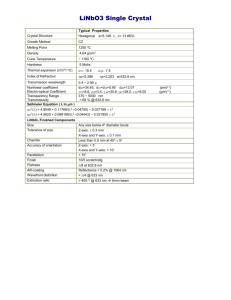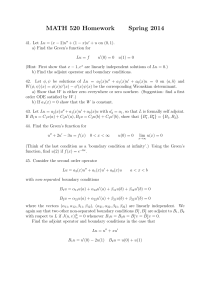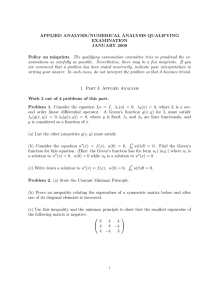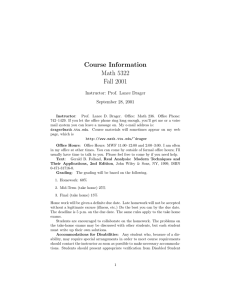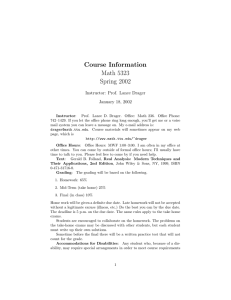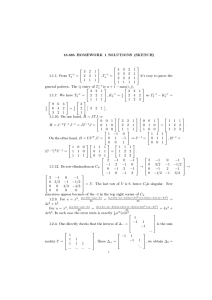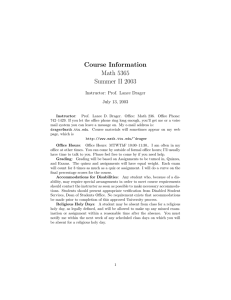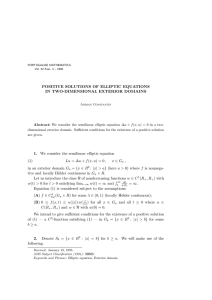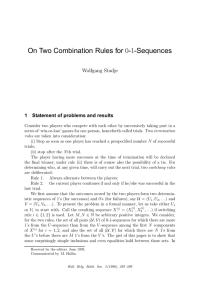SOLVING SECOND ORDER, HOMOGENEOUS EULER-CAUCHY
advertisement
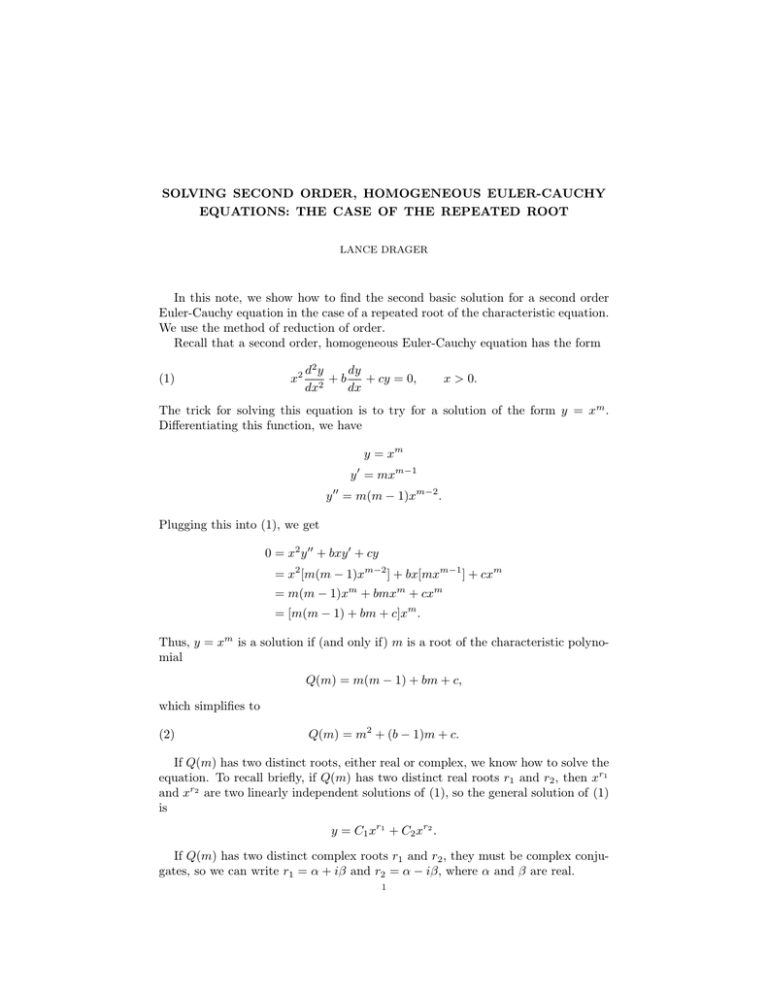
SOLVING SECOND ORDER, HOMOGENEOUS EULER-CAUCHY EQUATIONS: THE CASE OF THE REPEATED ROOT LANCE DRAGER In this note, we show how to find the second basic solution for a second order Euler-Cauchy equation in the case of a repeated root of the characteristic equation. We use the method of reduction of order. Recall that a second order, homogeneous Euler-Cauchy equation has the form (1) x2 dy d2 y +b + cy = 0, 2 dx dx x > 0. The trick for solving this equation is to try for a solution of the form y = xm . Differentiating this function, we have y = xm y 0 = mxm−1 y 00 = m(m − 1)xm−2 . Plugging this into (1), we get 0 = x2 y 00 + bxy 0 + cy = x2 [m(m − 1)xm−2 ] + bx[mxm−1 ] + cxm = m(m − 1)xm + bmxm + cxm = [m(m − 1) + bm + c]xm . Thus, y = xm is a solution if (and only if) m is a root of the characteristic polynomial Q(m) = m(m − 1) + bm + c, which simplifies to (2) Q(m) = m2 + (b − 1)m + c. If Q(m) has two distinct roots, either real or complex, we know how to solve the equation. To recall briefly, if Q(m) has two distinct real roots r1 and r2 , then xr1 and xr2 are two linearly independent solutions of (1), so the general solution of (1) is y = C1 xr1 + C2 xr2 . If Q(m) has two distinct complex roots r1 and r2 , they must be complex conjugates, so we can write r1 = α + iβ and r2 = α − iβ, where α and β are real. 1 2 LANCE DRAGER It’s perhaps not so clear what a complex power of x means, but since x > 0, we have x = eln(x) . If the complex power makes any kind of sense, we ought to have xα+iβ = (eln(x) )α+iβ = eln(x)(α+iβ) = eα ln(x)+iβ ln(x) = eα ln(x) eiβ ln(x) = (eln(x) )α [cos(β ln(x)) + i sin(β ln(x))] = xα cos(β ln(x)) + ixα sin(β ln(x)). Thus, we define xα+iβ = xα cos(β ln(x)) + ixα sin(β ln(x)) To justify using this definition to solve Euler-Cauchy equations, we need to check our definition has the property d α+iβ x = (α + iβ)x(α+iβ)−1 . dx We leave this check to the reader. The reader should also check that xα+iβ = xα−iβ . We can also check that our two solutions xr1 and xr2 are independent. For example, we can use the Wronskian. We conclude that in the case of complex roots the general complex solution of (1) is y = A1 xr1 + A2 xr2 , where A1 and A2 are arbitrary complex constants. To find the real solutions, we set y = ȳ and find the conditions that must be satisfied by A1 and A2 . The result is that in this case the general real solution of (1) is y = C1 xα cos(β ln(x)) + C2 xα sin(β ln(x)) for arbitrary real constants C1 and C2 . Finally, there is the case where Q(m) has only one real root r of multiplicity two. In this case, we get one solution y1 = xr of (1) and we need to find a second solution that is independent of y1 . This can be done by the method of reduction of order. To apply this method we look for a solution of the form y = u(x)y1 , where y1 is the solution we already know. Before plugging this in, we need to rewrite the differential equation in the right form. Since r is a root of Q(m) of multiplicity two, we must have Q(m) = (m − r)2 . Thus, we have m2 + (b − 1)m + c = Q(m) = (m − r)2 = m2 − 2rm + r2 . Thus, we must have c = r2 b − 1 = −2r =⇒ b = 1 − 2r. Plugging these values into (1), we can rewire (1) as (3) x2 y 00 + (1 − 2r)xy 0 + r2 y = 0. THE CASE OF THE REPEATED ROOT 3 Our trial solution is y = u(x)y1 = u(x)xr . Differentiating this gives y = uxr y 0 = u0 xr + ruxr−1 y 00 = u00 xr + ru0 xr−1 + ru0 xr−1 + r(r − 1)uxr−2 = u00 xr + 2ru0 xr−1 + r(r − 1)uxr−2 . Now plug these derivatives into equation (3). Here we go: 0 = x2 y 00 + (1 − 2r)xy 0 + r2 y = x2 [u00 xr + 2ru0 xr−1 + r(r − 1)uxr−2 ] + (1 − 2r)x[u0 xr + ruxr−1 ] + r2 [uxr ] = u00 xr+2 + 2ru0 xr+1 + r(r − 1)uxr + (1 − 2r)u0 xr+1 + r(1 − 2r)uxr + r2 uxr = u00 xr+2 + u0 [2rxr+1 + (1 − 2r)xr+1 ] + u[(r(r − 1)xr + r(1 − 2r)xr + r2 xr ] = u00 xr+2 + u0 xr+1 [2r + 1 − 2r] + uxr [r2 − r + r − 2r2 + r2 ] = u00 xr+2 + u0 xr+1 . Thus, we get the equation u00 xr+2 + u0 xr+1 = 0 for u. Dividing both sides by xr+2 gives the equation 1 0 u = 0. x If we set v = u0 , we get the first order equation u00 + 1 v = 0. x (This method is called reduction of order because it reduces a second order problem to a first order problem.) We can solve (4) by separation of variables, or by noting that it is a first order linear equation with integrating factor x. Multiplying both sides by x gives (4) v0 + 0 = xv 0 + v = d (xv), dx so we have C . x We’re only looking for one u that works, so we can choose the value of C, say C = 1. This gives us 1 u0 = v = . x Integrating, we get that u = ln(x) xv = C =⇒ v = (again, we can set the constant of integration to 0 because we’re only looking for one u that works). Plugging into our trial solution, y = uxr , we conclude that the second solution of (1) in the case of a double root r is xr ln(x). It’s pretty clear that these are independent solutions, so the general solution of (1) in the case of a double root r is y = C1 xr + C2 xr ln(x). 4 LANCE DRAGER Department of Mathematics and Statistics, Texas Tech University, Lubbock, TX 79409-1042, USA E-mail address: lance.drager@ttu.edu
